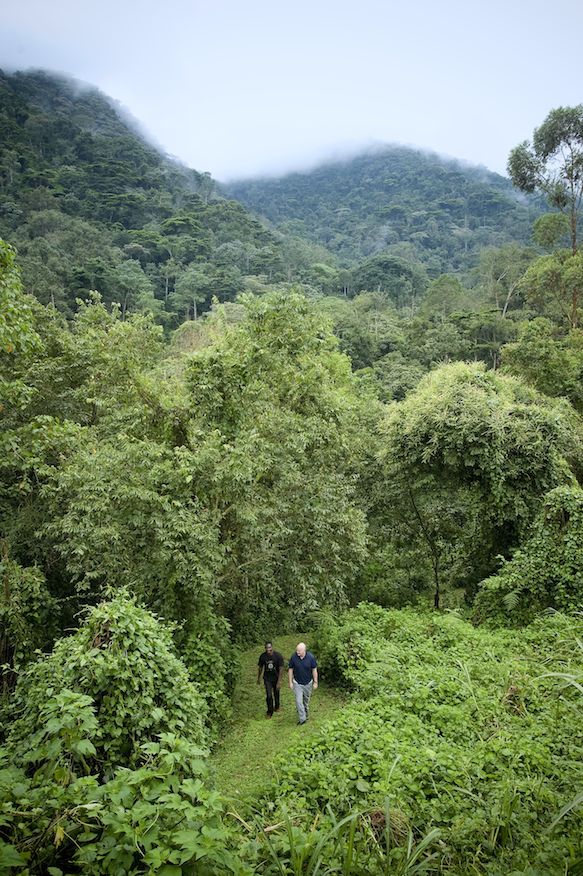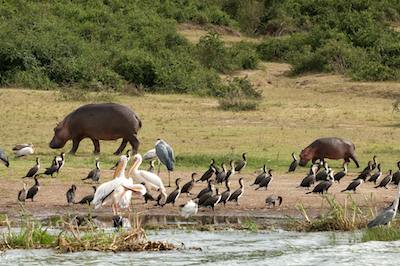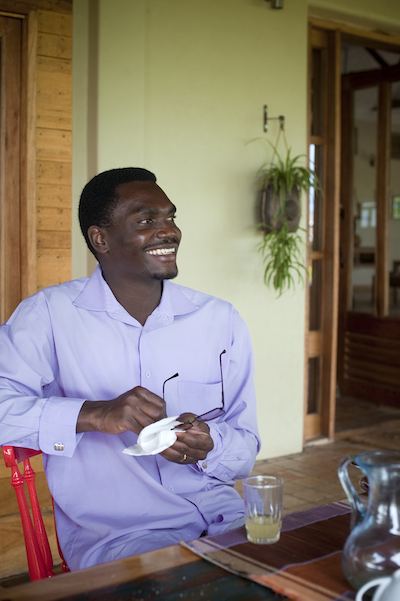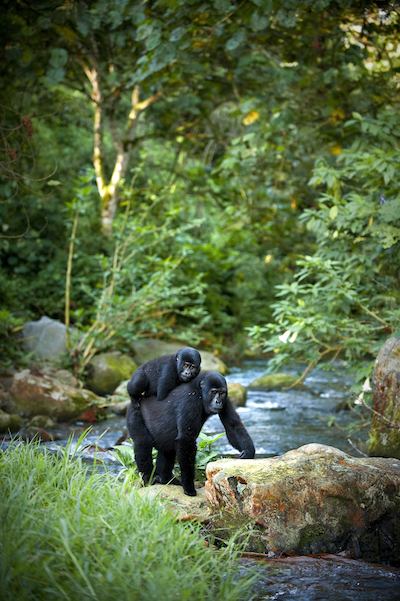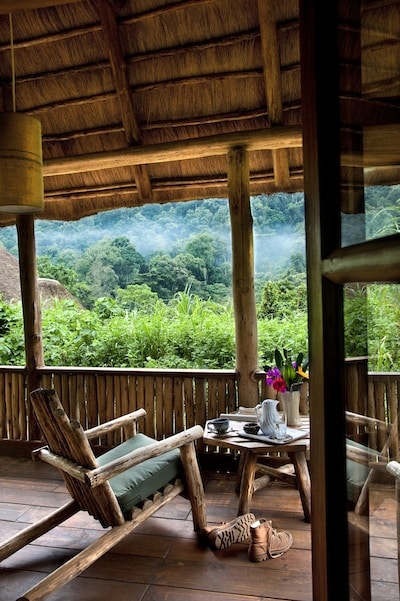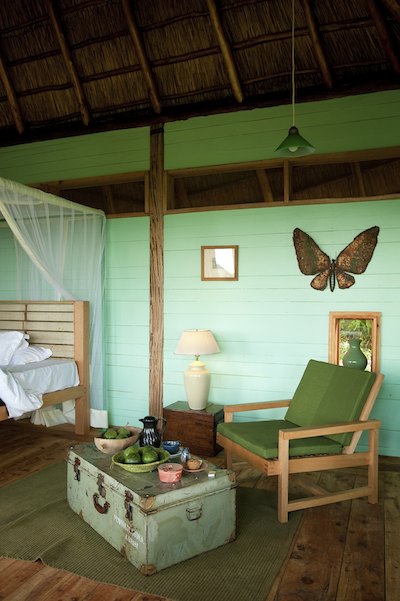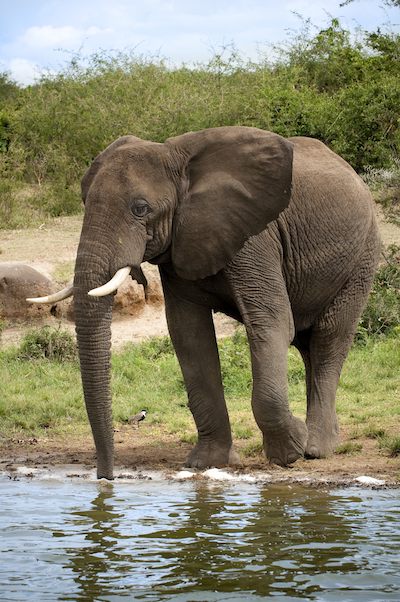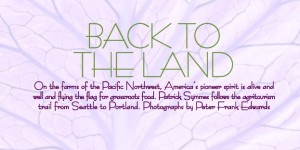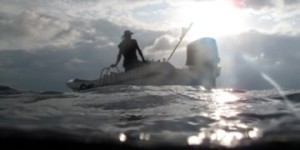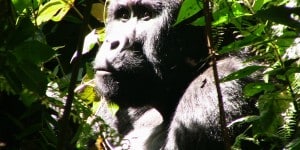We shared a room at the Hotel Diplomate in Kampala, Uganda, which was slightly awkward. Despite nearly a decade of email and scratchy Skyping, years of sending hope and Western Union transfers across the world, here, dividing up the beds in our room, was the first time we had met. My roommate, Patrick Otim, was only 29. But with his line mustache, small goatee, and sober manner, he seemed grave beyond his years. He probed his mattress at the Diplomate, tentative. “I don’t like a soft bed,” he said.
One night in the 1990s, his school campus in Gulu, Uganda, had been raided by a notorious warlord named Joseph Kony. A refugee, like most students, Patrick slept on the ground at night, unable to afford a bed or a mattress. He had just a mat of reeds.
“I couldn’t sleep very well on that thing,” he explained. “So I woke up right away, and ran and hid.”
Children with real beds, lost in their dreams, didn’t wake up in time. Many were kidnapped and used as child soldiers.
“That’s why I can’t sleep on a soft mattress,” he said, poking the Diplomate bedding one more time. “I’m afraid I won’t wake up.”
Patrick has had a lot of hard beds in his life. Born in southern Sudan, he was only 7 when his family fled to the Democratic Republic of the Congo and from there, into the refugee camps of Uganda.
But fear, flight, and bad bedding were not Patrick’s only story. I was here in Uganda with him because Patrick’s difficult life had finally taken a better turn. Tomorrow, after 10 years of epic effort on his part and with financial support from my wife, Beth, he would graduate from medical school. He was a day away from completing one of the most improbable ascents in the world, from refugee to M.D.
If a soft mattress was suspect, then the modest Diplomate—a lovely old crackpot of a hotel with a stuffed lion in the stairwell—was luxury beyond the horizon of Patrick’s world. He was currently a trainee surgeon, earning $300 a month from Uganda’s public health service.
This $75 room in the Ugandan capital would be my treat. But that was only the beginning. To celebrate his graduation—and my own family’s role in making it possible—we were embarking on a week of touring around Uganda. After tomorrow’s graduation, Patrick would be a doctor. And for the next week, a tourist. We were headed to see mountain gorillas and savanna lions, a classic safari itinerary that would immerse us in a privileged world of game lodges and rich meals, the kind of big animal experience and telephoto holiday that foreigners seek here. “I find myself the lucky one,” he told me, awed by his own circumstances. “A man with two lives.”
That night we gathered at the Diplomate’s pool table with Dje Dje, a tall Dinka man from Sudan who couldn’t sink the eight ball but was already a skilled surgeon. Patrick switched between Sudanese Arabic (with Dje Dje), French (with a Congolese colleague of Dje Dje’s), English (with me), and Luganda (the language of the Ugandan hotel staff ). I bought warm Tusker beers, only to discover that Patrick doesn’t drink. He was exhausted, not celebratory, worn down by six months in rural clinics, sometimes patching up machete wounds by the light of a cell phone. Kampala, big and noisy, unnerved him, he said.
At 7 the next morning, a cool November dawn, I helped him don the black graduation robe and green hood signaling his medical studies. With his mother back in South Sudan, and his father and seven siblings in a Uganda refugee camp, I was the closest thing to family he had at the graduation. We walked down from the hilltop Diplomate, cutting through red-dirt lanes that smelled of charcoal. At each intersection, more graduates appeared, a rivulet of black gowns that became a stream and then a flood of 2,000 graduates crowding toward the gates of Kampala International University.
The ceremony was glorious and tardy, with roasting sun, bouts of rain, and high spirits. The business students whooped the loudest when their turn came, and no wonder. East Africa’s economy is growing at a rate approaching 7 percent a year, and the African middle class as a whole—future customers, clients, employers, and employees— has tripled in size over the last 30 years.
At last, the doctors were called forward, and 50 bright-faced men and women lined up for the Hippocratic oath. Patrick, with his Sudanese frame, stood taller than the Ugandans and Kenyans around him. He put on his habitual serious face, removed his graduation cap, and raised a hand for the oath. One journey was over; another now began.
The next day, we climbed into a Land Rover, nicely tricked out by our tour operator, Volcanoes Safaris, which specializes in visiting the mountain gorillas and wildlife of western Uganda. In front, driving us, was Wilson, a 10-year veteran guide and Uganda native. Kampala traffic gave way to green hills, banana plantations, and towns painted in the yellow and red of competing cell phone advertisements. After eight hours of flat pavement came steeper dirt roads, and we began climbing into the line of volcanic mountains that edge the Rift Valley and divide the nations of the region. We drove around troops of baboons and crossed a deep gorge on a bridge with more holes than structure. (“Very old bridge!” Patrick cried out midspan.) The ridgetops gave long views of Uganda. The peaks were sharp, the lakes huge, the valleys wide. “Incredible,” Patrick whispered. “The terrain is incredible.”
As a child, Patrick often had to feed his family by hunting birds and fishing, crossing forest, mountain, and savanna in his refugee peregrinations. But this was nature on a different scale, with trembling volcanoes and a deep forest that protected the last mountain gorilla populations in the world. There are just around 780 of these magnificent animals alive today, inhabiting the forests of four of the region’s national parks: Uganda’s Bwindi Impenetrable National Park and Mgahinga Gorilla National Park; Virunga National Park, located just west in the Democratic Republic of the Congo; and Volcanoes National Park in Rwanda to the south.
At dusk, we passed some soldiers guarding the home of a politician. This prompted a wry debate between Wilson and Patrick over who was the worst politician in Uganda.
And then, road numb after 10 hours, we finally arrived in darkness at Volcanoes Safaris’ Bwindi Lodge, a string of elegant thatched bungalows with balconies that look across a ravine at the hills of Bwindi Impenetrable National Park, which sprawls over 320 square kilometers. There are a handful of lodges in Bwindi, almost all built like this one to face the steep, mist-covered forest. We sat on the balcony of our bungalow for a while, listening to a distant squabble among red-tailed monkeys.
Patrick seemed relaxed and happy for the first time on our trip. Bwindi felt like home, rural Africa, the mountains redolent of crossings and new beginnings. He went straight to bed, and unlike our first night at the hotel in Kampala, didn’t check the mattress.
We woke up in a mood of ruthless efficiency. Each tourist in Bwindi Impenetrable National Park is given one—and only one—chance to see gorillas, a closely scheduled, costly encounter. A gorilla-viewing permit, which must be booked in advance, costs $750 and allows visitors one hour of viewing time once the gorillas have been approached. Known officially as a “gorilla tracking activity,” this is basically a walk in the woods. If you happen to be sick on the appointed date, or you miss your transport, too bad.
We left the Bwindi Lodge well before 6 a.m., and drove an hour over mud ruts as schoolchildren made their long way down the hills toward what a sign identified as the Jolly and Lowly School. After two hours we climbed to a halt near a set of huts at 6,000 feet in the southern section of the park. Amid conifers, a dozen men in the green fatigues of the Uganda Wildlife Authority were waiting. Each group of tourists is escorted by one senior UWA wildlife guide, one or two trackers (who know where the gorillas actually are), and additional porters and guards.
Our UWA guide, Obed Tukwasibwe, gave us a briefing in slow, careful English, discussing the habits and behavior of gorillas, safety issues, and the rules for tourists. (Don’t get closer than 15 feet. Don’t sneeze, since they catch our diseases. Don’t wave a walking stick, which could be mistaken for a spear.)
Our group would first hike to where a clan of gorillas had been observed the previous day. “At that place,” Obed said, “the trails are scattered. You must look for the main trail where the gorilla family went. You will see broken leaves and branches. You follow that trail to the nests where they spent last night. And on from there.”
He made it sound routine. “Remember,” he cautioned, “we don’t always have an appointment with them. It can take three hours, or the whole day. Prepare for the worst. If it is not tough, you’re lucky.”
The hiking was hot and steep, and the impenetrable forest lived up to its name, with towering trees wrapped in vines and layers of heavy undergrowth. Obed had us tuck our pants into our socks, to protect against forest ants and stinging nettles. After just 25 minutes of steep up-and-down hiking that covered us in sweat, a low, black form stepped out of the ferns, loped across the trail, and vanished into the brush.
We fell silent. On the hillside above, we heard leaves rattling.
Obed and his trackers conferred, and we began creeping slowly up the hill. Two paramilitary guards with fatigues and AK-47s preceded us. “Take it easy,” Obed said to us as the gunners passed by. “They are part of the team. That’s how we work in all Ugandan national parks.”
We didn’t expect them to use their guns, because we didn’t expect any trouble from the gorillas. Back in 1970, Dian Fossey had upended the old Hollywood image of gorillas as violent savages baring their fangs. Readers of National Geographic saw adult gorillas grooming Fossey’s hair and then handing over their infants for play time. In 2,000 hours of observing mountain gorillas, Fossey saw only five minutes of actual violence. She called the gorillas “introverted, peaceful vegetarians,” and her research sparked a wave of sympathy and support that now brings some 10,000 people to visit the Bwindi gorillas each year. Every permit is claimed well in advance.
“Maybe one day a year we don’t have tourists,” Obed whispered to me, as we inched into thick brush. The animals had learned not to fear humans, he said, but as we followed close on his heels, we abruptly confronted a nervous female who jumped up from a thicket of leaves and gave two quick double grunts, showing her teeth. It was a bluff, but we tumbled back in disarray. Hello, Hollywood.
“The size of them,” Patrick said, catching his breath after the retreat. He was grinning from ear to ear. He took off his glasses and cleaned them. Farther up the hill, along a trail of shredded ferns, we came to greenery so dense we couldn’t see 15 feet. The leaves were shaking, and whole branches crashed down. Gorillas spend most of their day eating salad: tender shoots and leaves that they select with epicurean finesse. They alternate bouts of chewing with short naps.
One of the UWA trackers slowly cut his way into the thickets with a machete, followed by Patrick, myself, Obed, and our guide, Wilson. We advanced a few yards, listened, and then advanced a few more, sliding on a mat of wet, half-crushed vegetation, with thorns and creepers grasping at us. Finally the leaves parted.
In the first eighth of a second that you come face to face with a gorilla, you undergo the shock of recognition. The gorillas’ eyes, ears, nose, lips, and teeth, their expressions and movements, are all familiar, almost identical to our own. This moment justifies the exorbitant fees, justifies all the bad roads, dust, and sweat. It is worth it for the simple revelation that we are cousins. You can state the fact, as Obed did, that we share about 98 percent of our DNA with the gorillas. It is another thing to look in their eyes and feel that closeness.
Once we had spotted the gorillas, Patrick and I spent our allotted hour thrashing slowly through the ferns, damp and happy, studying one giant after another as they chomped on branches, stripped off leaves, and alternated between resting and ripping up the forest. They pursued the eating-and-lazing agenda. We pursued them. From the sounds of moving branches, we could tell there were a dozen gorillas in the bushes, but we could see only one at a time, and even that required approaching within the range of a squirt gun sometimes.
Obed came back from scouting: “We found the leader,” he said, referring to the dominant male, called a silverback for his graying fur. We watched this huge creature for a while, 300 or 400 pounds of power, until some discreet sign changed Obed’s mind. “He’s scaring me now,” he said, and we withdrew.
Obed alerted us when our viewing hour had come to an end. We trekked back out of the forest, got in the Land Rover, and drove back to the Volcanoes Safaris lodge. On the ride back, Patrick told me that before today, the only gorilla he had previously seen was on Congolese currency. “I didn’t imagine the males could be so big,” he said. “The way they eat and move!”
Nothing could top that, right? So we thought. But after we returned to the lodge, we went for a walk at dusk, and ran smack into 16 more gorillas. An entire troop. They were eating their way through the hotel grounds, chewing ferns.
Without armed guards or professional guides or trackers, we held stock-still for an unexpected second golden hour. These gorillas were calm and seemingly bored. At one point they walked within inches of me on the narrow trail. There were three babies, a sign of a better future, and we stood riveted and reverent as the youngsters threw leaves at the adults. Eventually, when darkness set in, the babies climbed onto their mothers’ backs and the whole clan progressed, slowly, across a stream. The troop disappeared and went in search of beds for the night.
That day, we’d seen about two dozen mountain gorillas, maybe 3 percent of all those alive in the world.
When we returned to the lodge, my hands were trembling. I bolted down a glass of South African wine. Wilson looked at our faces and knew what had happened.
“Was it good?” he asked. “Very,” I said.
Patrick Otim’s first education was in Arabic, one of the official languages of Sudan. But in 1989, when he was just 7, ethnic and religious strife spread out from the Darfur region to engulf all of southern Sudan. Patrick’s family, Christians from the Acholi ethnic group, fled for the Democratic Republic of the Congo. They lived four years at Kaka 1, an improvised refugee camp, where his education continued in French. It was during those terrible years, following the death of his younger brother, that Patrick began to dream of medicine.
“I asked my mother, why did he die?” he recalled. There was a nurse but no doctor, his mother answered. Maybe the child had received the wrong medicine, or no medicine at all. “So I began chasing a dream. I would become the doctor he needed.” Patrick was 9 or 10 years old. In search of better conditions, the family decamped for Uganda in 1994, when Patrick was 12, riding for three weeks on the back of a Leyland truck and sleeping under mango trees. They settled at Adranga 1, a large refugee camp near Arua in northern Uganda. He started school over again, this time in his fourth language, English. But money was always a problem. In 1997, Patrick, then 15 and the eldest child, had to quit school to support his family. He loaded pickup trucks for tips and carried fish in the local market. His determination impressed a local man, who paid $500 to enroll Patrick for a year in a boarding school. Leaving his family behind, Patrick moved hundreds of miles across northern Uganda to the town of Gulu.
By 2000, Patrick’s $500 worth of tuition was exhausted and he returned to the refugee camp where his family waited. A private school—“no library or lab and a leaky roof”—accepted him. Patrick paid his school fees in labor, fetching water and hauling bricks on weekends. Even this impoverished school was “a chance to continue to dream,” Patrick recalled. In 2001, he passed his first Ugandan exams, but money had run out, and once again he was forced to quit school.
Ten years later, on the morning of his M.D. ceremony in Kampala, Patrick told me that the experience of having to leave school after passing his exams had been the most bitter moment in a life of bitter moments. “It was too much for me,” Patrick said. “Here I was, I knew I could study in any school and make it. I knew I could get into a university and make it. But I didn’t have any means to do it.”
He told me that he had considered suicide. It contradicted his Christian upbringing, but he felt trapped.
“You are the only person I have told that to,” he said.
In late 2002, my sister-in-law, Amy Segal, received some news: Uganda. That was the destination of her first assignment for Doctors Without Borders. Refugees, regional conflict, and disease outbreaks made Uganda an intimidating first assignment, but most of the problems were in the north. “Don’t worry,” a friend with experience in Uganda told me. “It’s not like they’re going to send her up north.”
They sent her north. Amy landed in Arua, a sprawling city near the tripartite borders of Uganda, Sudan, and the Democratic Republic of Congo. A transnational conflict burned in the region, at times involving rival Sudanese groups, Congolese army deserters, and the warlord Joseph Kony, subject of the viral video campaign “Kony 2012,” the man who had raided Patrick’s refugee camp on the night that hard bedding saved his life. Luckily, Amy was in the northwest, which was considered a relatively stable environment largely protected from violence by a large, impassable river.
Amy arrived in early 2003 to work on a pilot program for HIV treatment. At some point a local staffer mentioned a boy with good grades who had been in and out of school because he couldn’t afford tuition. That was Patrick Otim. Amy reached out and met Patrick’s family and school headmaster and agreed to pay his tuition for the next semester. After that semester, my wife, Amy’s twin, offered to sponsor the remainder of his high school education. With support and hope, Patrick worked obsessively, earning the fifth-best test scores in the region. From our home in New York, Beth shepherded Patrick toward a small medical school in western Uganda, a satellite of Kampala International University. He got in.
Suddenly, my wife had to pay for medical school in Africa. For the first year, she paid bills herself and poured time into fund-raising to pay for future tuition. Meanwhile, Patrick studied—biology, anatomy, organic chemistry—and became a doctor. Slowly, with difficulty, the bitter life of the refugee became one of hope, and the boy with no prospects became a man with two lives.
On our fifth day traveling, Patrick gave me a surprising lesson about the limits of charity. We walked from the hotel to the nearest medical clinic. Bwindi Community Hospital is staffed by Ugandan nurses and doctors. In addition to its specialized wards, there is a lab, an operating room, a pharmacy, and a medicine storehouse under constant assault from monkeys. Out of 100,000 people in this district, the clinic had reached 60,000 residents, and reduced newborn mortality from 25 percent to 6 percent.
“I’m very impressed,” Patrick said. “I really believe in this kind of community-based medicine.”
The secret to the community’s thriving clinic is that it charges money. In this desperately poor region of banana farmers and AIDS orphans, the hospital had enrolled 28,000 customers in a private insurance plan. Even by local standards, the cost was low: $3 a year for each person over the age of 5. Typically, Patrick noted, the poor waited too long to deal with medical problems, and were forced to sell a cow to fund expensive, last-minute treatments. (He’d once had to install a $300 sterile mesh insert into a man with a hernia, an operation that could have been prevented by a few $2 sutures had the patient come earlier.) This made costs higher and outcomes worse. With an insurance plan, people came early, saved themselves and the hospital money, and got better results.
The hospital still gets nearly 90 percent of its budget from charities and the government, but that small stream of patient revenue continues to provide some stability.
“There has to be community support for the hospitals,” Patrick explained. “The funding from the Ugandan government will never be enough. Free doesn’t work. In the end, free means no resources.”
Patrick’s dream, he said, was to open a clinic in his homeland, now the Republic of South Sudan, a nation born in July 2011. (As of today, Patrick is in South Sudan working for the World Health Organization.)
On the walk back up to the lodge, we heard the sound of drums. When we got to the main street—the only street—of Buhoma village, we found children singing and dancing in front of a tiny shack labeled bwindi actors. A drummer explained their mission: The town was full of AIDS orphans who had once begged from the gorilla tourists. Now the kids learned crafts and put on shows for the visitors. Kids as young as my own 4-year-old son were leaping about joyfully and performing traditional dances, as well as some that were not so traditional, such as a costumed gorilla dance in which three boys rolled around in black coveralls and masks, tossing leaves and pounding their chests in fairly accurate imitation of the local celebrities.
Our weeklong trip was nearly finished. From Bwindi Impenetrable National Park we cut north, heading through Queen Elizabeth National Park and arriving long after dark at Kyambura Gorge, a second Volcanoes Safaris lodge, for a final night. From the long veranda where morning coffee was served we saw a vast grassland, dotted with gazelle and rustled by warthogs, with shattered remnants of volcanoes on the horizon. We spent a classic safari day here, floating on Lake George, spotting hippos and elephants as they watered themselves, and turning our binoculars on tiny malachite kingfishers and powerful lions. Patrick took out his cell phone and took pictures of himself with lions in the background.
“Fresh air, vegetation, animals,” he said, and inhaled deeply. We were six days into our week. The trip was working its magic, his mood now expansive, as rich as the sky itself. “I wish Beth and Amy were here,” he said casually.
Much has been said about the notion that cell phones ruin the experience of travel, but on the drive back to the lodge I impulsively dialed my wife back in the United States. Standing in the roof hatch of the Land Rover, as Wilson drove along the rim of a crater lake, Patrick broke out of his habitual reserve and unburdened himself to my wife, whom he has still never met. For 15 minutes they talked, and I could hear only his side of the conversation.
“It opened a new world for me,” he said, and then paused while she talked.
“It was a life-changing experience.” Pause.
“A once-in-a-lifetime experience.” Pause.
“You pulled me out of that danger I was in.” Long pause.
And, finally, that wondrous line again: “I’m living the life of a man with two lives.” A
Photos by Dook. Read about more ways to see gorillas in Africa. This appeared in the November/December 2012 issue.
